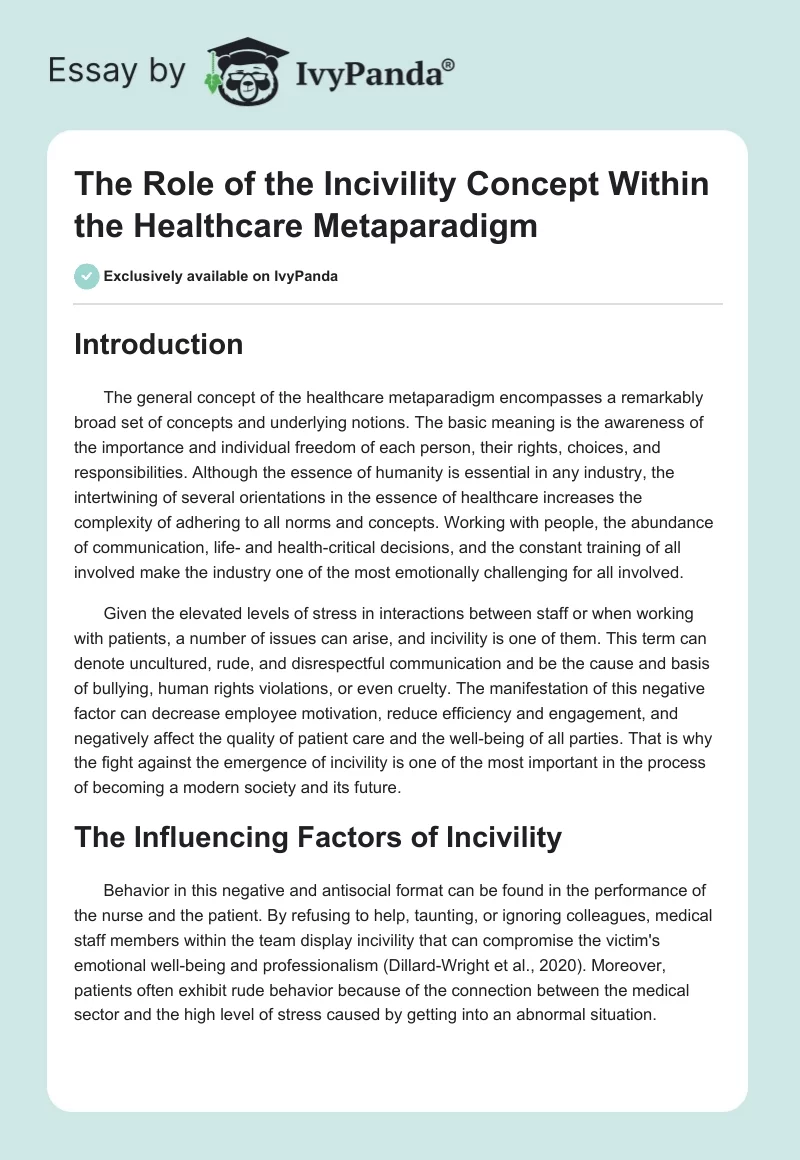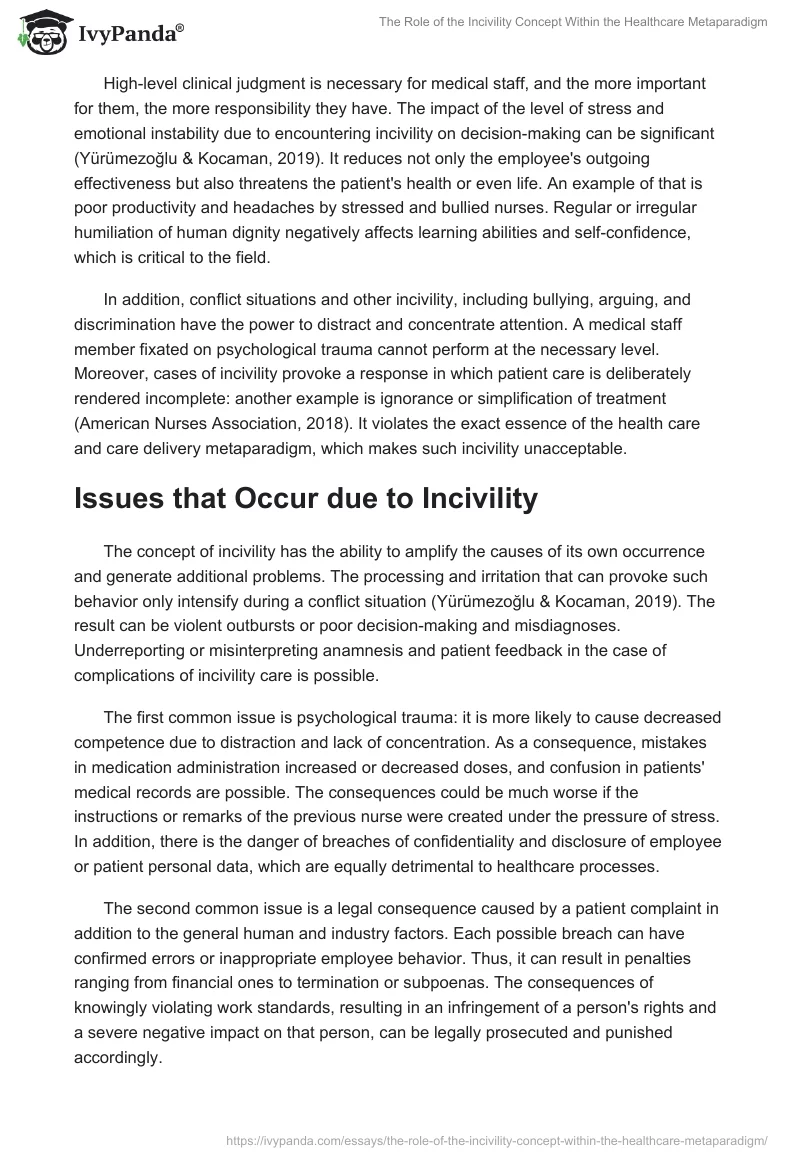Introduction
The general concept of the healthcare metaparadigm encompasses a remarkably broad set of concepts and underlying notions. The basic meaning is the awareness of the importance and individual freedom of each person, their rights, choices, and responsibilities. Although the essence of humanity is essential in any industry, the intertwining of several orientations in the essence of healthcare increases the complexity of adhering to all norms and concepts. Working with people, the abundance of communication, life- and health-critical decisions, and the constant training of all involved make the industry one of the most emotionally challenging for all involved.
Given the elevated levels of stress in interactions between staff or when working with patients, a number of issues can arise, and incivility is one of them. This term can denote uncultured, rude, and disrespectful communication and be the cause and basis of bullying, human rights violations, or even cruelty. The manifestation of this negative factor can decrease employee motivation, reduce efficiency and engagement, and negatively affect the quality of patient care and the well-being of all parties. That is why the fight against the emergence of incivility is one of the most important in the process of becoming a modern society and its future.
The Influencing Factors of Incivility
Behavior in this negative and antisocial format can be found in the performance of the nurse and the patient. By refusing to help, taunting, or ignoring colleagues, medical staff members within the team display incivility that can compromise the victim’s emotional well-being and professionalism (Dillard-Wright et al., 2020). Moreover, patients often exhibit rude behavior because of the connection between the medical sector and the high level of stress caused by getting into an abnormal situation.
High-level clinical judgment is necessary for medical staff, and the more important for them, the more responsibility they have. The impact of the level of stress and emotional instability due to encountering incivility on decision-making can be significant (Yürümezoğlu & Kocaman, 2019). It reduces not only the employee’s outgoing effectiveness but also threatens the patient’s health or even life. An example of that is poor productivity and headaches by stressed and bullied nurses. Regular or irregular humiliation of human dignity negatively affects learning abilities and self-confidence, which is critical to the field.
In addition, conflict situations and other incivility, including bullying, arguing, and discrimination have the power to distract and concentrate attention. A medical staff member fixated on psychological trauma cannot perform at the necessary level. Moreover, cases of incivility provoke a response in which patient care is deliberately rendered incomplete: another example is ignorance or simplification of treatment (American Nurses Association, 2018). It violates the exact essence of the health care and care delivery metaparadigm, which makes such incivility unacceptable.
Issues that Occur due to Incivility
The concept of incivility has the ability to amplify the causes of its own occurrence and generate additional problems. The processing and irritation that can provoke such behavior only intensify during a conflict situation (Yürümezoğlu & Kocaman, 2019). The result can be violent outbursts or poor decision-making and misdiagnoses. Underreporting or misinterpreting anamnesis and patient feedback in the case of complications of incivility care is possible.
The first common issue is psychological trauma: it is more likely to cause decreased competence due to distraction and lack of concentration. As a consequence, mistakes in medication administration increased or decreased doses, and confusion in patients’ medical records are possible. The consequences could be much worse if the instructions or remarks of the previous nurse were created under the pressure of stress. In addition, there is the danger of breaches of confidentiality and disclosure of employee or patient personal data, which are equally detrimental to healthcare processes.
The second common issue is a legal consequence caused by a patient complaint in addition to the general human and industry factors. Each possible breach can have confirmed errors or inappropriate employee behavior. Thus, it can result in penalties ranging from financial ones to termination or subpoenas. The consequences of knowingly violating work standards, resulting in an infringement of a person’s rights and a severe negative impact on that person, can be legally prosecuted and punished accordingly.
Possible Damage to Communication
Communication is the primary tool and medium of interaction in the healthcare industry. The teamwork of each unit signals its effectiveness and is mandatory for professional activities. Equally important is communication with patients to monitor their condition and assist with diagnosis and decision-making (Dillard-Wright et al., 2020). Taking this into account, the violation of communicative interactions leads to the destruction of relations in the team and the reduction of its efficiency.
It is not uncommon for medical staff to need advice or to ask for help directed to colleagues in the course of their work. Being rude, bullying, or deliberately refusing to offend is fraught not only with worsening the offended person’s emotional state but also with potential suffering for patients (American Nurses Association, 2019). For example, refusal of consultation may result in an increased dose of analgesia due to the insecurity of the administering staff, which may contribute to complications or death of the operated patients.
In the context of regular care, it is equally important to prioritize the work process. Under stress, a nurse may miss patient procedures or medications and not even remember to do so. Accordingly, situations that arise may be difficult to resolve because there are no obvious factors in their occurrence. Fear of rudeness may cause the nurse not to admit to the error, which again threatens the life and health of patients.
Current Initiatives and Procedures to Decrease Incivility
Current initiatives involve combating incivility, controlling its occurrence, and writing the rules of interaction to eliminate it. One of these methods is regular meetings and training in psychological resilience and teamwork (American Nurses Association, 2018). Monitoring of mood and relationships in the team is likewise done in parallel with monitoring the staff’s behavior toward patients. Those responsible for communication health are usually unit managers or in-house counselors.
In the format of conflicts with patients, debriefing or substitution tactics are usually employed. The unit staff tries to find out the causes of dissatisfaction and eliminate factors for their existence (Dillard-Wright et al., 2020). Thus, a permanent caregiver may be replaced, or the care method may be revised. In the process, incivility is assumed to be prevented and removed as an unnecessary item in health care.
In addition to the Code of Ethics for Nurses, there are a number of social movements that counteract the effects of incivility on healthcare professionals. An example of this is the professional issues group #EndNurseAbuse, which has developed a policy for timely reporting of incivility for nursing staff (American Nurses Association, 2019). The movements emphasize the importance of creating a culture of respect in the workplace and the unacceptability of all incivility.
Conclusion
Incivility in health care is a significantly dangerous factor by all accounts. Its negative impact on employees’ competence, motivation, concentration, and confidence poses a threat to the quality of any medical care. Only when combating any manifestation of the problem and maintaining a healthy communicative atmosphere both in the work team and with patients in treatment is it possible to achieve maximum efficiency in the department? The rules, regulations, and code of ethics for nurses and other medical personnel are instruments for that. They are designed to promote normalcy and stability of relationships in any medical care institution.
References
American Nurses Association. (2018). Incivility, bullying, and workplace violence. ANA. Web.
American Nurses Association. (2019). Violence, incivility, & bullying. ANA. Web.
Dillard-Wright, J., Walsh, J. H., & Brown, B. B. (2020). We have never been nurses: Nursing in the anthropocene, undoing the capitalocene. ANS. Advances in Nursing Science, 43(2), 132–146. Web.
Yürümezoğlu, H. A., & Kocaman, G. (2019). Structural empowerment, workplace incivility, nurses’ intentions to leave their organisation and profession: A path analysis. Journal of Nursing Management, 27(4), 732–739. Web.


